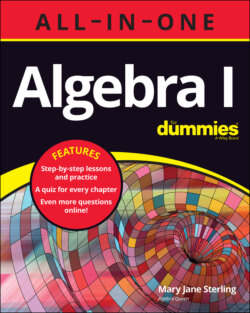Читать книгу Algebra I All-in-One For Dummies - Mary Jane Sterling, Mary Sterling Jane - Страница 79
Determining lowest terms
ОглавлениеA fraction is in its lowest common terms when there is no common factor of the numerator and denominator except the number 1. Nothing will divide both of them evenly.
To reduce fractions to their lowest terms, follow these steps:
1 Look for numbers that evenly divide both the numerator and the denominator.If you find more than one number that divides both evenly, choose the largest.
2 Divide both the numerator and the denominator by the number you chose, and put the results in their corresponding positions.
When reducing fractions, your fraction isn’t wrong if you don’t choose the largest-possible divisor. It just means that you have to divide again to get to the lowest terms. When reducing the fraction , you might have chosen to divide by 6 instead of 12. In that case, you’d get the fraction , which can be reduced again by dividing the numerator and denominator by 2. Choosing the largest number possible just reduces the number of steps you have to take.
Q. Write the fraction in lowest terms.
A. The divisors of 1001 are 7, 11, and 13. Are any of these divisors of 1540? Yes, 7 divides 1540 and 11 divides 1540. .
Q. Determine if the fraction is in lowest terms.
A. Yes. The numerator is divisible by 11 and 13. The denominator is divisible by 9 and 37. They don’t share any common factors, so this fraction is in its lowest terms.
11 Determine if the fraction is in lowest terms:
12 Determine if the fraction is in lowest terms:
13 Determine if the fraction is in lowest terms:
14 Determine if the fraction is in lowest terms:
